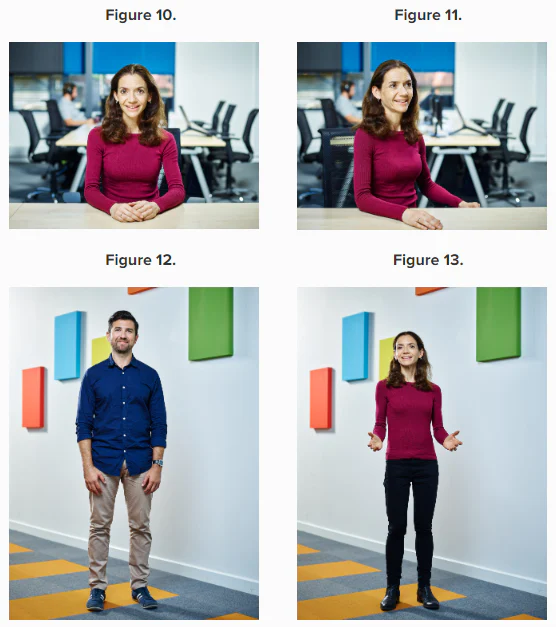What Is Positive Body Language?
Welcome to the world of positive body language! Ever wondered what it means and how it can impact your interactions with others? Well, you’ve come to the right place. In this article, we’re going to delve into the fascinating topic of what positive body language is all about.
Picture this: you’re chatting with a friend, and their smile is contagious, their eyes are locked onto yours, and they stand tall with open and relaxed body posture. How does that make you feel? That’s the power of positive body language! It’s the non-verbal cues we give off that communicate our confidence, friendliness, and genuine interest. It’s like a secret language we all speak, without even saying a word.
From a friendly handshake to maintaining eye contact, positive body language helps us connect with others on a deeper level. It can not only boost our own self-confidence but also make others feel comfortable and at ease in our presence. So let’s dive right in and explore the fascinating world of positive body language together!
Understanding Positive Body Language: A Key to Effective Communication
Positive body language is a powerful form of nonverbal communication that plays a significant role in conveying messages, building rapport, and establishing trust. It encompasses a wide range of physical behaviors, gestures, facial expressions, and postures that reflect positivity, confidence, and openness. Understanding and utilizing positive body language can greatly enhance your interpersonal skills and contribute to more successful interactions in personal and professional settings.
The Power of Eye Contact
Eye contact is a fundamental aspect of positive body language that has the potential to foster strong connections with others. When engaged in a conversation, maintaining appropriate eye contact demonstrates attentiveness and interest. It shows that you are actively listening to the person speaking and valuing their words. Additionally, eye contact can help establish credibility and trust. When you maintain eye contact, you create a sense of authenticity and sincerity, making others more inclined to trust and believe in what you say.
Eye contact can also be used as a subtle tool for persuasion. By locking eyes with someone while making a persuasive argument, you can convey conviction and confidence in your message. However, it is important to strike a balance. Overly intense eye contact can be perceived as aggressive or intimidating, so it’s crucial to maintain a friendly and approachable gaze.
The Importance of a Genuine Smile
A genuine smile is a universal signal of positivity and warmth. Smiling not only makes you appear more approachable and friendly but also has a contagious effect on those around you. When you smile, you release endorphins, which are the brain’s feel-good chemicals that can elevate your mood and create a positive atmosphere. A smile can help diffuse tension, break the ice, and establish a pleasant and welcoming environment.
However, it is essential to distinguish between a genuine smile and a forced or insincere one. A genuine smile involves the activation of the muscles around the eyes, known as the “crow’s feet.” This type of smile, also called a Duchenne smile, is associated with true happiness and authenticity. On the other hand, a fake smile only involves the movement of the mouth muscles. It is crucial to practice and develop the ability to generate genuine smiles, as they are more likely to create positive connections with others.
The Power of Posture
Your posture speaks volumes about your confidence, self-assurance, and overall demeanor. Standing or sitting upright with your shoulders back and your head held high demonstrates a sense of poise and self-assurance. It conveys confidence and authority, making others more inclined to respect and value your opinions. Good posture also supports better breathing, allowing you to project your voice more effectively and communicate with clarity.
However, it’s important to strike a balance. Adopting an overly rigid or stiff posture can come across as intimidating or unapproachable. Aim for a relaxed yet upright and open posture, with your body facing towards others. This conveys approachability and attentiveness, making it easier for others to engage in conversation and feel comfortable around you.
Open and Inviting Gestures
Positive body language involves the use of open and inviting gestures that convey inclusivity and openness to communication. Crossed arms or legs can create a barrier and convey defensiveness or disinterest. On the other hand, keeping your arms relaxed at your sides or using open hand gestures while speaking can create a more welcoming and approachable impression. These gestures indicate that you are receptive to new ideas, opinions, and perspectives. Keeping your hands visible and using gestures that align with your words can enhance your message and make it more impactful.
Mirror and Match
Mirroring and matching body language is a technique that involves subtly imitating the nonverbal cues of the person you are communicating with. This can include gestures, facial expressions, and body postures. Mirroring and matching create a sense of rapport and connection, indicating that you are on the same wavelength as the other person. However, it’s important to use mirroring and matching techniques subtly and sparingly to avoid appearing overly imitative or insincere.
When mirroring and matching, pay attention to the other person’s pace and intensity of movements. Match their energy level and try to adopt a similar rhythm in your gestures and body language. Mirroring and matching can help establish a sense of likeness and understanding, making the other person more receptive to your message.
The Power of Touch
Touch can be a powerful form of positive body language, albeit one that should be used with caution and appropriate boundaries. Appropriate touches, such as a handshake, high-five, or pat on the back, can create a sense of connection and warmth. Touch releases oxytocin, often referred to as the “bonding hormone,” which fosters trust and positive feelings. However, it’s crucial to be mindful of cultural norms, personal boundaries, and consent when utilizing touch as a form of positive body language.
In conclusion, positive body language is a powerful tool in effective communication. Through appropriate eye contact, genuine smiles, confident posture, open gestures, mirroring, and appropriate touch, you can create a positive and welcoming environment that fosters strong connections with others. By understanding and utilizing positive body language, you can enhance your interpersonal skills, improve your relationships, and communicate more effectively in various aspects of your life. Embrace the power of positive body language and watch as it transforms the way you connect with others.
Key Takeaways: What is Positive Body Language
- Positive body language includes smiling and maintaining good eye contact.
- Standing tall and having open posture conveys confidence and positivity.
- Using gestures to emphasize points can make your communication more engaging.
- Active listening, nodding, and facing the speaker show interest and attentiveness.
- Mirroring the body language of others can help build rapport and connection.
Frequently Asked Questions
Welcome to our FAQ section on positive body language! Here, we will answer some common questions about how body language can convey positive emotions and attitudes. Mastering positive body language can greatly impact your personal and professional relationships, so let’s dive into the questions!
1. How does positive body language impact communication?
Positive body language plays a crucial role in effective communication. When you exhibit positive body language, such as maintaining eye contact, smiling, and open postures, it signals interest, warmth, and approachability. This can help people feel more comfortable around you and encourages open and honest dialogue. Positive body language also supports active listening by nodding, making appropriate gestures, and leaning forward, expressing your engagement and attentiveness.
By adopting positive body language, you not only enhance your communication skills but also foster a positive atmosphere, improving the overall quality of your interactions and building strong connections with others.
2. Can you provide examples of positive body language in different settings?
Positive body language can be applied in various settings, be it personal or professional. In a social setting, leaning in towards someone when they are speaking, maintaining eye contact, and nodding to show understanding are all examples of positive body language. Smiling genuinely, using open and relaxed postures, and offering a firm handshake are also indicators of positivity.
In a professional setting, positive body language can help establish credibility and build rapport. Good examples include maintaining good posture, using appropriate hand gestures while speaking, and mirroring the body language of the person you are conversing with. Active listening cues, like nodding and using facial expressions to show interest, are equally important.
3. How can positive body language be used to exude confidence?
Positive body language can play a significant role in exuding confidence. Standing tall with your shoulders back, maintaining eye contact, and offering a firm handshake are powerful ways to convey confidence. Using purposeful and deliberate hand gestures can also enhance your assertiveness.
Additionally, adopting open postures, such as keeping your arms uncrossed and facing people directly, signals approachability and self-assurance. When you combine these gestures with a genuine smile, you’ll exude even more confidence and make a positive impression on others.
4. How does positive body language impact job interviews?
Positive body language is essential during job interviews. It helps create a positive first impression and establishes a strong connection with the interviewer. Maintaining eye contact throughout the interview shows attentiveness and interest, while smiling can convey friendliness and warmth.
Using open and relaxed postures demonstrates your confidence and openness to new opportunities. Employing confident hand gestures while discussing your qualifications and maintaining good posture shows professionalism. Remember that positive body language can help you stand out from other candidates, making you more memorable and increasing your chances of landing the job.
5. Can positive body language improve personal relationships?
Absolutely! Positive body language is crucial for building and maintaining healthy personal relationships. It conveys trust, empathy, and respect, creating an environment where people feel safe to express themselves. Using active listening cues, such as nodding, maintaining eye contact, and smiling, helps establish a strong emotional bond.
Open and relaxed postures, like uncrossed arms and facing the person directly, demonstrate your willingness to engage and connect. Offering gentle touches, like a pat on the back or a warm hug, can also convey affection and comfort. By consistently using positive body language, you can nurture deeper connections and foster stronger relationships with your loved ones.
Summary
Positive body language is all about how we use our bodies to communicate. It includes things like smiling, making eye contact, and standing tall. By using positive body language, we can show others that we are confident, friendly, and approachable. It can help us make a good impression and build better relationships with others. Remember, using positive body language doesn’t just benefit others, it also makes us feel good about ourselves. So let’s practice open and inviting body language to create a positive and welcoming environment wherever we go.


